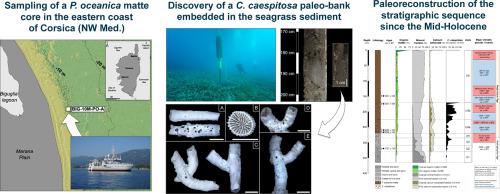Estuarine, Coastal and Shelf Science ( IF 2.6 ) Pub Date : 2021-04-23 , DOI: 10.1016/j.ecss.2021.107378 Briac Monnier , Léa Lehmann , Stéphane Sartoretto , Christine Pergent-Martini , Miguel Ángel Mateo , Gérard Pergent

|
Along most Mediterranean coasts, the endemic seagrass species Posidonia oceanica builds extensive meadows and complex peat-like bioconstruction known as ‘mattes’. These belowground deposits are recognized as a valuable long-term archive allowing the reconstruction and the study of palaeo-climatic and palaeo-ecological changes in the coastal environment over the Holocene period. One of the P. oceanica matte cores sampled during a coring survey along the eastern continental shelf of Corsica Island (France, NW Mediterranean) revealed the unprecedented finding of a dead bank of the scleractinian coral Cladocora caespitosa embedded in the matte. Measurement of the morphological and biometrical features of corallite fragments coupled to biogeosedimentological analysis and radiocarbon dating contributed to provide a basis for the reconstruction of the stratigraphic sequence since the mid-Holocene (last 4750 years). The study of the sediment core enabled identification of three major phases: (i) the settlement of the C. caespitosa colonies (~4750-3930 cal yr BP), (ii) the coexistence of the C. caespitosa bank and the P. oceanica meadow (~3930-1410 cal yr BP), followed by (iii) the death of the coral bank and the development of only the P. oceanica meadow (~1410 cal yr BP-present). The sclerochronological analysis completed on the well-preserved corallite fragments revealed that the mean annual growth rate of the coral ranged between 1.9 and 3.1 mm yr−1 with a mean value estimated at 2.3 ± 0.8 mm yr−1. Trend analysis showed semi-millennial to millennial oscillations in annual growth rates which are probably related to environmental climatic changes since the Cold Phase of the Subatlantic period (2925-2200 cal yr BP). During the Roman Warm Period (2200-1500 cal yr BP), the decline and the death of the bank (~1410 cal yr BP) was probably due to the combined effect of a prolonged increase in summer temperatures and an increase in the competition with the P. oceanica meadow.
中文翻译:

Posidonia oceanica千年档案记录的Cladocora caespitosa库的长期动态
在大多数地中海沿岸,特有的海草物种Posidonia oceanica形成了广阔的草甸和复杂的类似于泥炭的生物构造,被称为“无光泽”。这些地下沉积物被认为是有价值的长期档案,可以对全新世时期沿海环境中的古气候和古生态变化进行重建和研究。其中的P.大洋洲沿科西嘉岛(法国,NW地中海)东部大陆架取心调查期间采样磨砂内核透露的造礁石珊瑚死银行的空前发现Cladocora子草嵌入到遮罩中。珊瑚岩碎片形态和生物特征的测量,再加上生物地质沉积学分析和放射性碳定年,为全新世以来(最近4750年)以来地层层序的重建提供了基础。沉积岩心的研究启用的三个主要阶段鉴定:(i)本结算C.子草集落(〜4750-3930 CAL年BP),(二)并存C.子草银行和P.大洋洲草甸(约3930-1410 cal BP年),其次是(iii)珊瑚堤的死亡和仅P. oceanica的发育草甸(约有1410 cal yr BP到现在)。对保存完好的珊瑚岩碎片的年代学分析表明,珊瑚的年平均生长速率在1.9和3.1 mm yr -1之间,平均值估计为2.3±0.8 mm yr -1。趋势分析显示,自亚大西洋冷期(2925-2200 yr BP)以来,年增长率从每千年到千年波动,这可能与环境气候变化有关。在罗马暖和时期(2200-1500 cal yr BP),银行的衰落和死亡(〜1410 cal yr BP)可能是由于夏季气温持续升高和竞争加剧而共同造成的。在P.大洋洲的草甸。











































 京公网安备 11010802027423号
京公网安备 11010802027423号